Do DHT Levels Increase As You Get Older?'
Name: Alfie
Question: Is it true DHT levels increase as you get older? I want to know about men and male pattern baldness really. Is that why older men are bald a lot of the time?
Answer: Hi, Alfie. A man's dihydrotestosterone / DHT levels are certainly thought to be affected by ageing, however, it has been shown that, rather than increasing, it is more likely that DHT will decrease with age.
For the benefit of other readers, DHT is the testosterone by-product which causes follicular miniaturisation, leading to thinning hair and the typical symptoms, such as a receding hairline, of Male Pattern Baldness in men with an active genetic predisposition.
A widely-quoted clinical study from 1977, published in the Japanese Journal of Endocrinology, examined the serum DHT and testosterone (T) levels in 78 men aged between 12 and 89 years old.
They were separated into groups by age and the following were studied - 20-39 years, 40-59 years, 60-79 years and 80-89 years.
In these four age groups, the following mean /- SEM (standard error of the mean) measurements were recorded:
20-39 years = 98 12 serum DHT (ng/100 ml); 696 /- 27 serum testosterone (ng/100 ml)
40-59 years = 91 /- 9 serum DHT (ng/100 ml); 698 /- 18 serum testosterone (ng/100 ml)
60-79 years = 82 /- 7 serum DHT (ng/100 ml); 624 /- 20 serum testosterone (ng/100 ml)
80-89 years = 54 /- 15 serum DHT (ng/100 ml); 457 /- 21 serum testosterone (ng/100 ml)
As you can see, the DHT levels steadily decreased in each age group.
As a result, the findings reported "a significant decline in DHT and T levels of 80- to 89-year-age group compared those of 30- to 39-year-age group (p less than 0.05 and p less than 0.005 respectively). But there was no significant changes in DHT and T levels between other age groups."
Years later a team from Massachusetts, USA, also investigated correlations between the effects of ageing on DHT levels; they published their findings in The Journal of Clinical Endocrinology & Metabolism on 1st February 2002.
These researchers noted that the data they reviewed, taken from the Massachusetts Male Aging Study - described as "a large population-based random-sample cohort of men", comprising medical information for 1,709 men aged between 40 and 70 years of age, suggested DHT levels remained constant, whereas testosterone levels dropped as men got older.
They found the link between ageing and androgen levels going down may actually be to do with the increased risk of illness later in life.
"Apparent good health, defined as absence of chronic illness, prescription medication, obesity, or excessive drinking, added 1015% to the level of several androgens... incident poor health may accelerate the age-related decline in androgen levels," they concluded.
With regards to Male Pattern Baldness and men losing their hair as they get older, there is indeed a correlation here. This hereditary condition can technically present, in those who are predisposed to it, any time following puberty. However, the older a man gets, the more likely he is to experience this type of hair loss.
For instance, it is widely understood that instances of Male Pattern Hair Loss increase roughly in line with age. So, by age 20, around 20 per cent of men may experience its onset, rising to 30 per cent of 30 year olds and 40 per cent of 40 year olds.
Interestingly, figures for hair loss by the age of 50 appear to vary wildly depending on which country you are in. The American Academy of Dermatology states that an anticipated 85 per cent of men will experience some level of Male Pattern Baldness by age 50, compared to just 50 per cent of all UK men, according to the British Association of Dermatologists.
There are a number of established factors which can exacerbate existing cases of men's hair loss, or trigger the onset of premature balding, the main culprit being stress in its many and varied forms. Due to the pressures of modern life - and something known as oxidative stress in particular - this is thought to be the reason behind rising cases of hair loss in young people. The American Hair Loss Association estimates that a quarter of men will now start to lose their hair before the age of 21.
Another reason for older men being more likely to be bald is that Male Pattern Baldness is a permanent, progressive condition. Therefore, if action is not taken to prevent hair loss - such as following a hair loss treatment course featuring one or both of the clinically-proven medications for this condition - the affected follicles - located around the top of the scalp, from hairline and temples to crown - will continue to deteriorate.
The hair growth cycle will slow down, with hairs becoming finer and weaker, until the follicles are no longer capable of producing hair. The scalp will then take on the smooth, shiny appearance associated with true baldness.
At this point, hair regrowth will not be possible even with the assistance of MHRA-licensed and FDA-approved hair loss solutions, and it may also be too late for surgical hair restoration; in cases where a hair transplant is not possible, cosmetic options such as hair pieces or wigs could be explored if the individual is uncomfortable with their hair as it is.
We hope this answers your query and if you are concerned about experiencing any signs of hair loss or a drop in the volume of your hair, we recommend having a consultation at a dedicated hair loss clinic for personalised advice and information.

The Belgravia Centre
The Belgravia Centre is a world-renowned group of a hair loss clinic in Central London, UK. If you are worried about hair loss you can arrange a free consultation with a hair loss expert or complete our Online Consultation from anywhere in the world for home-use treatment.
View our Hair Loss Success Stories, which includes the world's largest gallery of hair growth photos and demonstrates the level of success that so many of Belgravia's patients achieve.


